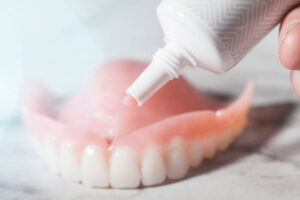 An adhesive is not something you should rely on to keep your dentures in place. Suction should be all that’s needed. However, denture adhesive can be helpful when you need a little extra stability, like during a speaking engagement or when preparing for a steak dinner. There are many types of adhesives available. It may take some experimentation to find the best type and brand for you. Here’s how to use the 3 most common types of denture adhesive.
An adhesive is not something you should rely on to keep your dentures in place. Suction should be all that’s needed. However, denture adhesive can be helpful when you need a little extra stability, like during a speaking engagement or when preparing for a steak dinner. There are many types of adhesives available. It may take some experimentation to find the best type and brand for you. Here’s how to use the 3 most common types of denture adhesive.
Applying an Adhesive Cream
An adhesive cream comes in a small tube, which makes it easy to apply in 4 simple steps:
- Clean and dry your dentures.
- Rinse your mouth before placing your dentures in your mouth.
- Apply the adhesive to the underside of your denture in short strips. Avoid applying too much to prevent oozing.
- Place your dentures in your mouth and hold them in place. Bite down firmly for a few seconds to create a seal.
Although a cream adhesive is easy to use, it can take some trial and error to determine the correct amount to use for an all-day hold.
Applying Denture Adhesive Powder
Denture adhesive powders are sprinkled on for easy application. Here are 5 steps to ensure you use it correctly:
- Clean your dentures, but do not dry them.
- Rinse your mouth with water.
- Apply a small amount of adhesive evenly onto the undersurface of your dentures.
- Shake off any excess powder.
- Insert your dentures into your mouth, hold them in place, and bite down to maintain a secure hold.
Powder adhesives can be a bit messier than other types. But, with a little practice, you can ensure you’re placing the right amount with little mess.
Applying Denture Adhesive Strips
Denture adhesive strips are a popular choice because they are pre-measured and easy to use. Here’s how to apply the strips correctly:
- Clean and dry your dentures.
- Rinse your mouth.
- Lightly moisten one strip with a small amount of water.
- Place the strip on your dentures without any overlapping
- Insert your denture in your mouth and bite down to hold it in place.
Removing a Denture Adhesive
At the end of the day, you’ll need to clean your dentures and remove the adhesive. Here’s how to ensure there’s no residue lingering on your dentures:
- Rinse your mouth with warm water before removing your dentures.
- Remove any adhesive with a soft-bristled toothbrush and warm water.
- After cleaning your dentures, place them in an overnight soaking solution to kill over 99% of bacteria.
If you’re relying on an adhesive to stop your dentures from slipping, it’s time to visit your dentist you have them rewind. Regular relining will help you maintain a snug fit to get the most from your dentures.
About Dr. John P. Carroll
Dr. Carroll achieved his dental degree from the Tufts University School of Dental Medicine and has continued his education in many specialties, including dental implants, cosmetic dentistry, and dentures. He is affiliated with the American Dental Association, the Connecticut Dental Association, and many other professional organizations. Request an appointment through his website or call his office at (860) 368-0133.







